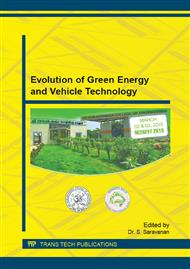[1]
Engin Gedik, Hüseyin Kurt, Ziyaddin Recebli, Corneliu Balan, Two-dimensional CFD simulation of magnetorheological fluid between two fixed parallel plates applied external magnetic field, Computers & fluids, 63 (2012) 128–134.
DOI: 10.1016/j.compfluid.2012.04.011
Google Scholar
[2]
Zekeriya Parlak, Tahsin Engin, Ismail Calli, Optimal design of MR damper via finite element analyses of fluid dynamic and magnetic field, Mechatronics, 22 (2012) 890–903.
DOI: 10.1016/j.mechatronics.2012.05.007
Google Scholar
[3]
F. Herr, T. Mallin, J. Lane and S, Roth, A shock absorber model using CFD analysis and Easy5, Journal of Society of Auromotive Engineers, Paper No. 1999-01-1322 (1999).
DOI: 10.4271/1999-01-1322
Google Scholar
[4]
Stephen A. Austin, An analytical solution for the unsteady flow of a bingham plastic fluid in a circular tube, NUWC-NPT Technical Report 11, 011, 17 October 1995 submitted to Naval Undersea Warfare Center Division, Newport, Rhode Island.
Google Scholar
[5]
Weng W. Chooi, S. Olutunde Oyadiji, Design, modelling and testing of magnetorheological (MR) dampers using analytical flow solutions, Computers and structures, 86 (2008) 473–482.
DOI: 10.1016/j.compstruc.2007.02.002
Google Scholar
[6]
I Sahin, T Engin and S Cesmeci, Comparison of some existing parametric models for magnetorheological fluid Dampers, Smart materials and structures, 19 (2010) 035012.
DOI: 10.1088/0964-1726/19/3/035012
Google Scholar
[7]
I. A. Brigadnov and A. Dorfmann, Mathematical modeling of magnetorheological fluids, Continuum Mech. Thermodyn., (2005) 17: 29–42.
DOI: 10.1007/s00161-004-0185-1
Google Scholar
[8]
S. R. Hong, et al in Non dimensional analysis and design of a Magnetorheological damper, Journal of Sound and Vibration, 288 (2005) 847–863.
DOI: 10.1016/j.jsv.2005.01.049
Google Scholar
[9]
Bogdan Sapinski, Jacek Filus, Analaysis of parametric models of MR linear damper, Journal of theoretical and applied mechanics 41, 2, pp.215-240, Warsaw (2003).
Google Scholar
[10]
Walid H., El-Aouar (2002) Finite element analysis based modelling of magneto rheogical dampers, MS thesis, Virginia Polytechnic Institute and State University, USA.
Google Scholar
[11]
Daniel Garcia-Pozuelo, et al, Bump Modeling and Vehicle Vertical Dynamics Prediction, Advances in Mechanical Engineering, Vol 2014, Article ID 736576 (2014).
DOI: 10.1155/2014/736576
Google Scholar


